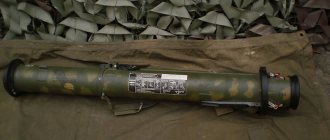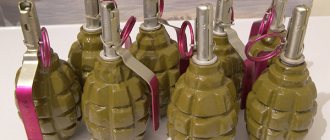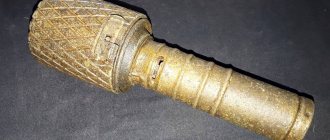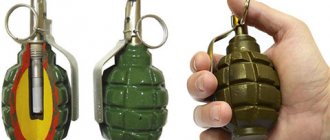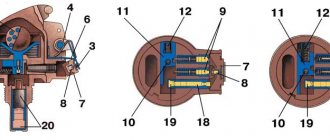Hand grenade Eihandgranaten 39 / M-39
| Eihandgranaten 39 (M-39) |
The Eihandgranaten 39 (M-39) hand grenade was a type of remote-action fragmentation offensive grenade with a grating fuse.
The grenade was adopted by the Wehrmacht in 1939 and was used by Germany throughout the Second World War. Until the end of the war, about 80 million grenades of this type were produced.
In appearance, it looks like a large egg and was an almost exact copy of the French OF 15 grenade of the 1915 model, but with a German-style grating type fuse.
Eihandgranaten 39 (M-39)
Structurally, the grenade consisted of an ovoid metal body, an ignition device and a detonator.
The body of the grenade was stamped from two halves of thin iron, one of which contained a connecting tube with a sleeve for the detonator. The channel of the connecting tube has a thread for connecting the frame of the ignition mechanism to the grenade body.
At the bottom of the body, late-release grenades have a loop with a ring for ease of wearing. Typically, grenades were hung in a ring from the straps of standard cartridge pouches to a Mauser carbine.
The body was filled with an explosive substance - amatol (a mixture of ammonium nitrate and TNT).
The ignition mechanism, in turn, consists of a frame in which there is a moderator, a detonator, a grater with a pull cord and a safety cap strip and a clamping nut.
grenade device Eihandgranaten 39 (M-39)
The grenade is equipped with a standard BZE grating fuse (BZE – Brennzünder für Eihandgranate). It consists of a body, a rubbing mechanism, a bushing with a retarder and a detonator capsule number 8 - Sprengkapsel Nr.8 (SPR. Kaps. Nr.8).
A nut is screwed onto the metal body, with which the fuse is screwed into the grenade body. Sometimes the nuts were equipped with claws for ease of screwing or unscrewing. There is a grating mechanism inside the body. At the bottom of the body there is a thread for screwing in a bushing with a powder retarder. During storage of the grenade, a safety thimble was screwed onto the sleeve. At the battalion ammunition supply point, before being given to the soldiers, the thimble was removed, and the detonator cap was screwed directly onto the sleeve.
The grating mechanism of the BZE fuse consists of a cap, a wire float with a cord and a capsule with a grating compound located in the upper part of the body. A wire float is passed through a grating compound. The second end of the lace is attached to the cap.
The red cap indicated an ignition delay time of 1 s, blue 4-4.5 s, and yellow 7-7.5 s. Typically a retarder of 4-4.5 s was used.
Before using a grenade, you must: 1. Unscrew the ignition mechanism from the grenade body and make sure that the detonator sleeve is free of foreign bodies. 2. Remove the safety thimble from the retarder. 3. Screw the assembled ignition mechanism into the grenade body and secure the clamping nut with a wrench (if the nut has tabs, tighten it by hand).
To use a grenade you must: 1. Unscrew the safety cap from the ignition mechanism. 2. Holding the grenade with your right hand, sharply pull the safety cap with your left hand, remove the lanyard with a grater and throw the grenade at the target.
At the moment the traction cord is pulled out, the grater straightens and ignites the grater composition, the beam of fire of which is transmitted through the moderator to the detonator, and the grenade explodes.
The radius of continuous destruction by fragments is 5 meters, the radius of scattering fragments is up to 15 meters.
Eihandgranaten 39 (M-39) with a defensive case.
Grenades were stored and transported in wooden boxes of 30 pieces in an unfinished form (fuses and detonator caps separately). Special nest-cages were made in the boxes. The boxes were stenciled with the following inscription: “Heers-Munition Gesamgewicht 12.5 kg” (Ammunition Total weight 12.5 kg). In addition, the label “30 Stuck Eihandgranaten 39 Zum Gebrauch 30 BZ fur Eihgr 39 und 30 Sprengkapseln Beipacken Wdg abgenommen Wdg” was pasted on. 1942 Ltg" (30 pieces of egg-shaped hand grenades model 39, 30 grate igniters for the egg-shaped grenade 39 and 30 detonator caps in a bag). The final equipment was produced at the battalion ammunition supply point, and was issued to the soldiers in the final equipped form.
Garnets could be painted in various colors - green, gray, ocher. From the middle of the war they were only covered with drying oil, and from the autumn of 1944 they were not painted at all.
Often on the fuse cap and body you can find the WaA (WaffenAmt) stamp, as well as the manufacturer’s stamp.
defensive case for grenades Eihandgranaten 39 (M-39)
Order OKH (Ch H Rüst u. BdE) Nr. 8142/44 AHA/ln 2V dated September 19, 1944, it was prescribed to use a defensive case with Eihandgranate 39 grenades - Splittermantel für Eihandgranate (Spl M f Eihgr). The defensive cover increases the radius of scattering of fragments to 100 meters, and accordingly the radius of destruction also expands significantly.
The defensive case for grenades of this type consists of two steel halves with round holes at the top, which are attached to each other with a special lock. Notches are applied to their surface for greater efficiency in scattering fragments.
The grenade with a defensive case was prescribed to be used only from a reliable shelter due to the large radius of damage from fragments.
The order also prescribed that the share of grenades with a cover should be 30% of all Eihandgranate 39 grenades that go to the troops.
training grenade Eihandgranate 39 Übung
To teach the rules of using grenades, the training grenade Eihandgranate 39 Übung was created.
The training grenade consists of a body, an igniter, the same as a combat grenade, and a small smoke charge Übungsladung 30. The body is painted red and has round holes on the body. The holes in the body are designed to allow smoke to escape, and also so as not to confuse this training grenade with a combat one in the dark. The weight of Eihandgranate 39 Übung reached 225 grams.
The Eihandgranate 39 (M-39) grenade can also be thrown from a 26 mm Walter system flare pistol equipped with a detachable stock and sight.
To throw grenades, a special brass sleeve is used, which is inserted into the barrel of the pistol. This sleeve has two holes in the center. When preparing a grenade for firing from a signal pistol, the fuse is removed and a special tube is screwed in instead. This tube has a retardant whose burning time is similar to that of a grenade fuse retardant. Before using it for its intended purpose, the same detonator cap number 8 was put on the moderator tube.
The grenade, assembled with a tube, is inserted into the pistol barrel from the muzzle, and a cartridge case is inserted from the breech of the pistol barrel. Before placing a grenade with a tube into the barrel of a pistol, the safety cotter pin of the tube is removed by pulling out the ring.
When fired, the powder gases of the expelling charge of the tube push the firing pin, which in turn breaks the upper igniter capsule, and the beam of fire from it is transmitted to the retarder. At the same time, powder gases enter the cartridge case through six nozzles located around the circumference of the pan and knock out the tube along with the grenade. After the moderator burns out, the grenade explodes.
The weight of the tube was 100 g. The weight of the grenade assembled with the tube reached 300 g. The tubes were stored and transported together with their bodies, 16 pieces per box. In addition, one cartridge case was placed in the box.
When storing Eihandgranate 39 grenades, the condition of the body was periodically checked, because the amatol with which these grenades were equipped is hygroscopic. When exposed to moisture, it caused corrosion and destruction of the grenade body. In addition, make sure that the safety caps are not screwed together.
M-39 grenades were popular among soldiers, since due to their good sealing, there were practically no failures due to dampness of the fuse.
| Grenade weight, g | 220 |
| Charge mass, g | 110 |
| Explosive type | amatol |
| Grenade length, mm | 98 |
| Case length, mm | 77 |
| Case diameter, mm | 60 |
| Deceleration time, s | 4 — 4.5 |
A significant disadvantage of the M-39 grenade was that after pulling out the ignition cord, the grenade had to be thrown.
During the Great Patriotic War, the Eihandgranate 39 (M-39) grenade was also used by Red Army soldiers and partisan detachments. Among the captured grenades, there were many assembled grenades, prepared for throwing, with a detonator cap installed, and undischarged ones. To train personnel, a description of their design and instructions for use were published in “Brief Descriptions of Hand Grenades”, published by the Military Publishing House of the USSR NPO in 1942 and 1944.
Almost half the weight of the M-39 grenade was the explosive charge; it was the same as that of Soviet hand grenades of the RG-42 and RG-41 types. At the same time, domestic grenades used TNT as an explosive, and the German grenade was loaded with a weaker explosive based on ammonium nitrate. Therefore, in terms of high-explosive action, Eihandgranate 39 was approximately equivalent to Soviet grenades, and in terms of fragmentation action, the M-39 grenade was less effective.
The M-39 grenade had some advantages over the other German mass-produced M-24 grenade in that it was much more compact, and the weight of three M-39 grenades was almost equal to one M-24 grenade.
Bayonet | Italy
Bayonet M-1891
The bayonet was used with rifles and carbines of the “Carcano” system of the 1891 and 1891/1924 models. It was produced in 1890-1910. The blade is straight, single-edged, with a fuller on both sides. The fighting end is double-edged. The handle is formed by two wooden cheeks, fastened to the shank with two rivets. The steel head of the handle has a T-slot and a spring latch with an internal coil spring. The cross is straight, with a ball at the end and a ring for the barrel on the butt side of the blade. Leather scabbard with a brass or iron device, consisting of a mouth with a peg and a tip, or a steel one with a peg. Only until the end of the First World War, about 3.5 million bayonets were produced. Performance characteristics of the bayonet: total length - 415 mm; blade length - 300 mm; blade width - 22 mm; blade thickness - 4.5 mm; the internal diameter of the ring in the cross is 13.3 mm.
Model 1891TS bayonet
Scabbard for bayonet mod. 1891TS
The bayonet is made on the basis of a bayonet mod. 1891 and was produced in 1898-1919. It was used with a carbine of the “Carcano” system mod. 1891 for special troops. The blade is straight, single-edged, with a fuller on both sides. The fighting end is double-edged. The handle is formed by two wooden cheeks, fastened to the shank with two rivets. The steel head of the handle has a T-slot and a spring latch with an internal coil spring. The cross is straight, with a ball at the end and a ring for the barrel on the butt side of the blade. Leather scabbard with a brass or iron device, consisting of a mouth with a peg and a tip, or a steel one with a peg. Pendant made of dark green leather. Bayonets were also used in Yugoslavia. Performance characteristics of the bayonet: total length - 424 mm; blade length - 300 mm; blade width - 22 mm; blade thickness - 4.5 mm; the internal diameter of the ring in the cross is 13.3 mm.
Bayonet model 1938
Bayonet arr. 1938 with a non-folding blade was used with rifles and carbines of the “Carcano” system mod. 1891/38. The blade is steel, straight, single-edged, blued, with one fuller on both sides. The combat end is double-edged. The handle is formed by two wooden cheeks, fastened to the shank with two screws. The steel head of the handle has a T-slot and a spring latch with an internal coil spring. The cross is straight, with a ring for the barrel on the butt side of the blade. The sheath is steel with an insertable spring-loaded mouth and an almond-shaped peg. For 1938-1945 331 thousand bayonets were produced. Performance characteristics of the bayonet: total length - 290 mm; blade length - 180 mm; blade width - 21 mm; the internal diameter of the ring in the cross is 13 mm.
Bayonet arr. 1938 with a fixed blade for rifles and carbines of the Carcano system
The bayonet was a transitional model from the folding bayonet mod. 1938 to awkward. In the production of the bayonet, handles from folding bayonets and blades from a folding or non-folding version were used. The blade was fixed in the fighting position with a new guard. The bayonet was used with the Carcano rifle mod. 1891/38 A total of 57.4 thousand bayonets were produced. Performance characteristics of the bayonet: total length - 290 mm; blade length - 180 mm; blade width - 21 mm; blade thickness - 4.5 mm; the internal diameter of the ring in the cross is 13 mm.
Folding bayonet mod. 1938
The bayonet was used with the Moschetto Automatico Beretta Modello 1938a submachine gun.
It was developed on the basis of the bayonet for the M-38 carbine and differed from it in the length of the blade and the T-shaped protrusion on the guard. The blade is straight, steel, single-edged, with a fuller on each side. The fighting end is two-edged. The handle is formed by two wooden cheeks, fastened to the shank with two screws. The steel head of the handle has a T-slot and a spring latch with an internal coil spring. The latch button is located in the middle part of the handle. Crosspiece with a T-shaped protrusion on the side of the blade butt. The blade locking button is located in the crosspiece. Steel scabbard with bracket. A total of 2.5 thousand bayonets were produced. Performance characteristics of the bayonet: total length - 310 mm; blade length - 200 mm; handle length - 110 mm; blade width - 20 mm; blade thickness - 4.5 mm. Share to:




